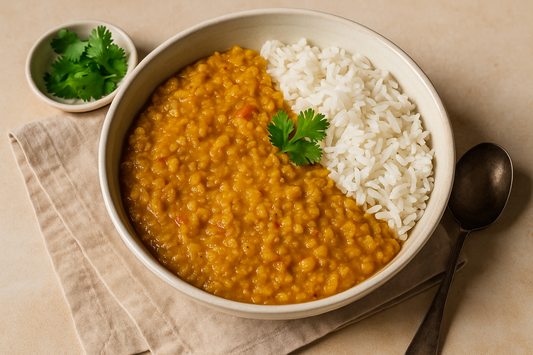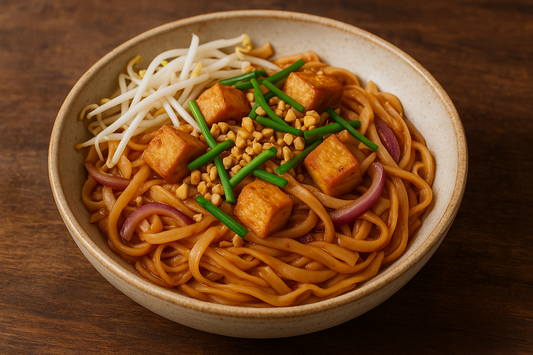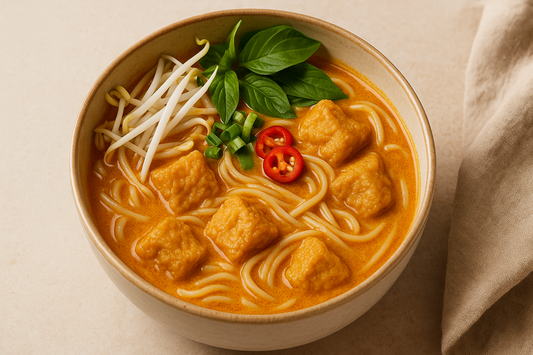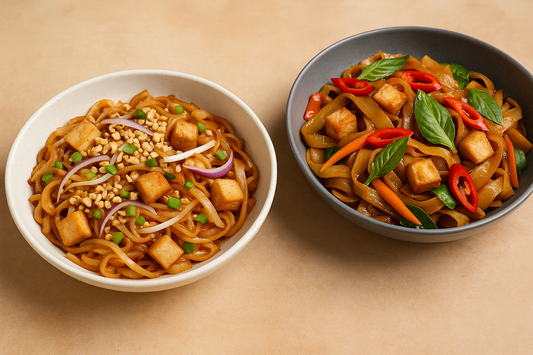Ever found yourself staring at a Korean menu, unsure what the names actually mean? From bibimbap to jajangmyeon, Korean food names aren’t just labels — they’re packed with history, meaning, and cultural pride.
In this blog, we’re decoding some of the most common Korean dish names you’ll come across, including the ones you can enjoy at home thanks to Pam Pam’s ready-made Korean meals. Whether you’re just getting started with Korean cuisine or want to deepen your knowledge, this guide will help you appreciate what goes into every bowl.
1. Japchae (잡채) – Stir-Fried Glass Noodles
What it means:
‘Jap’ means “to mix” and ‘chae’ means “vegetables.” So, japchae literally translates to “mixed vegetables,” but the star of the show is actually the glass noodles made from sweet potato starch.
Traditionally served during Korean celebrations and holidays, japchae is a lightly savoury-sweet dish packed with colourful veggies and sesame oil.
✅ Try it at home: Pam Pam’s Authentic Korean Glass Noodles Japchae is the perfect way to enjoy this classic dish without any prep work. Ready in minutes and completely plant-based.
2. Jajangmyeon (짜장면) – Black Bean Noodles
What it means:
‘Jajang’ refers to the fermented black bean paste used in the sauce, and ‘myeon’ simply means “noodles.” The name tells you exactly what it is: noodles coated in a rich, savoury black bean sauce.
Jajangmyeon is the ultimate Korean-Chinese comfort food, and while it originated in Chinese restaurants in Korea, it’s now a national staple — often eaten on singles’ day or when moving into a new home!
✅ Pam Pam pick: Our Korean Black Bean Noodle is a plant-based version of this hearty dish. It’s rich, flavourful, and deeply satisfying.
3. Bibimbap (비빔밥) – Mixed Rice with Vegetables
What it means:
‘Bibim’ means “mixed” and ‘bap’ means “rice.” Bibimbap is all about bringing together warm rice, sautéed vegetables, gochujang (chili paste), and often a fried egg or meat.
Even though we don’t offer bibimbap just yet, its name alone teaches a lot about Korean food: the emphasis is on harmony — balancing colours, textures, and flavours in a single bowl.
4. Kimchi (김치) – Fermented Vegetables
What it means:
‘Kimchi’ is a category of traditional fermented vegetables, typically napa cabbage or radish. The word itself doesn’t refer to a single dish but rather the entire fermentation tradition.
In Korean cuisine, kimchi isn’t just a side — it’s a part of everyday life, eaten with nearly every meal. It also represents Korea’s deep-rooted focus on gut health and preservation techniques, much like our blog on gut-friendly plant-based meals.
5. Tteokbokki (떡볶이) – Spicy Rice Cakes
What it means:
‘Tteok’ means “rice cake” and ‘bokki’ means “stir-fried.” These chewy rice cakes are cooked in a fiery red gochujang-based sauce, often served as a street snack.
Even if we don’t make this one (yet), it’s a great example of how Korean food names describe the cooking process as much as the ingredients.
Understanding Korean Food Naming Patterns
Here are a few common patterns that can help you decode other names on your own:
-
-myeon (면): Refers to noodles. Examples: jajangmyeon, naengmyeon
-
-bap (밥): Refers to rice dishes. Examples: bibimbap, kimchi bokkeumbap
-
-jjigae (찌개): Refers to stews. Examples: kimchi jjigae, doenjang jjigae
-
-tang (탕): Refers to soups. Examples: sundubu tang, samgyetang
-
-jeon (전): Refers to pancakes or fritters. Examples: pajeon, kimchi jeon
Recognising these suffixes helps you understand the structure and type of dish, even if you’re unfamiliar with all the ingredients.
Why Korean Food Names Matter
Korean dish names aren’t just identifiers — they carry cultural significance, historical context, and a deep sense of pride. From describing key ingredients to hinting at how it’s prepared, each name tells a story.
By learning these meanings, you:
-
Make smarter choices when ordering or cooking
-
Appreciate the care and balance behind every meal
-
Feel more connected to Korean food culture overall
Want to Try Korean Cuisine the Easy Way?
You don’t need a pantry full of fermented sauces and specialty noodles to experience authentic Korean flavours. Pam Pam’s plant-based range makes it simple to dive into this rich culinary world with meals that are:
-
Vegan and heat-and-eat ready
-
Made with whole ingredients and no preservatives
-
Inspired by the real thing, from Japchae to Jajangmyeon
Start here:
More Korean Food Reads from the Pam Pam Blog
📌 The Ultimate Guide to Jajangmyeon
📌 How Korean Cuisine Supports One of the World’s Healthiest Lifestyles









